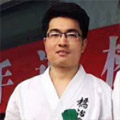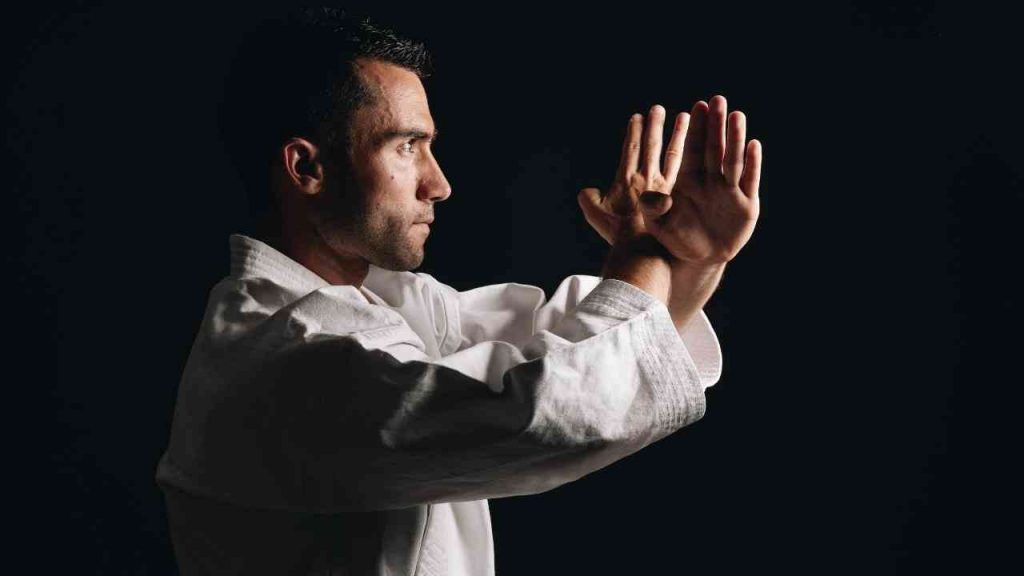Have you ever wondered why Uechi Ryu Karate is so similar to Chinese martial arts – Kung Fu?
I always did.
When I was aspiring to become a karateka, I observed many different Karate forms. But even after observing many, Uechi Ryu’s practices, unique moves, katas and the humility karateka possesses, always intrigued me.
After a year, I started practising Uechi Ryu myself and that’s when I found out why Uechi Ryu Karate possesses chunks of Chinese art forms.
So, let me tell you the tale of this blended Chinese and Okinawan Art form, ‘Uechi Ryu’.
Let’s begin…
Table of Contents
What Is Uechi Ryu?
Uechi Ryu Karate is one of the most significant Okinwara martial arts styles in Japan which is named after Kanbun Uechi. It was founded in the mid 1900s and is still used effectively. This style has a taste of both Chinese and Okinawan karate which is why it is referred to as Uechi karate in Japan and Kung-Fu in the US, China, and other parts of the world.
This Uechi style of karate uses both soft and hard fighting skills which require the practitioners to harmonize their mind, spirit, and body. It is a popular karate style in the domain of self-defense and close combat which is why it requires both flexibility and body strength.
What Makes Uechi Ryu Unique?
Uechi Ryu Karate is one of the most realistic and crucial-looking fighting techniques amongst all other karate styles. In Uechi ryu training, practitioners not only learn to control their body but they prepare it to fight for longer periods by controlled breathing and body training. Each kata, punch, stance and kick of Uechi Ryu is aimed towards protecting one’s self from close enemy encounters.
The basic emphasis of Uechi Ryu is on learning the art of harmonizing one’s mind and body and coordinating them in fights.The hardening and curing exercises like Sanchin, and Kote makes them learn when to defend and when to attack. This is why, for a Uechi Ryu practitioner it is crucial to have both strength, resilience and flexibility in their body.
And that is not it, the study of these karate techniques enhances the intrapersonal qualities of the practitioner as it enhances patience and wisdom in them.
The Orientation Of Uechi Ryu
The Roots of Okinawan’s Uechi Ryu Karate heads back to the Shaolin Temple of Northern China. It was originally the karate form that was used in Chinese temple fights under the name of Fwange-Nun.
Fwange Nun was constructed on fighting moves similar to tigers, dragons, and cranes. The moves of this style focused more on using Knuckle punches, Hand spear strikes, circular block, and toe pointing kicks.
The History Of Uechi Ryu
Kanbun Uechi, The founder of Uechi Ryu Karate was born in Izumi village in the year 1877 in Okinawa. He spent his early life in Okinawa learning basic martial arts. But, after he turned 20, he moved to China as he did not want to serve in the Japanese military.
In the Fukien province of China, he found a Buddhist priest Shushiwa who had mastered the art of the Chinese temple fight “Fwange Nun.” Uechi got so intrigued by the Chinese martial art form that he became a student of Shushiwa and learned Fwange Nun for the next ten years.
In the Nanchong city of Fukien, Kanbun himself became a master and taught student Fwange Nun for three years. In 1910, Master Uechi became popular as the first Okinwanian to be accepted in China as a martial arts teacher.
Then in 1927, the Uechi family moved to Osaka, Japan where Kanbun started teaching his son the art of Fwange Nun. These classes slowly continued and that’s when the term Uechi-Ryu was first introduced in Japan. In 1940, the style was named after Uechi in Japan.
Techniques Of Uechi Ryu
Most Chinese martial arts moves are inspired by animals. The fighting forms were developed by watching animal fights and bringing those techniques into human fighting practices.
Uechi Ryu Karate Katas
In Japanese, Kata means form. Katas are the basis of any martial art form. It teaches the basic moves, kicks, and pouches of the art. Uechi Ryu consists of eight katas in which the basic three Katas are Sanchin, Sanseiryu, and Seisan.
| No. | Kata Name | Brief Introduction | Demonstration |
|---|---|---|---|
| 1 | Sanchin | Sanchin means ‘three battles’. It refers to the battles of body, mind, and spirit. It also means harmonizing the nervous system, blood circulation, and organs. It is considered the oldest and most crucial kata of Uechi Ryu. | Check |
| 2 | Kanshiwa | Kanshiwa is the second kata of Uechi Ryu. It is also called the Tiger Kata due to its moves. The name is derived from the names of Kanbun Shushiwa and Kanbun Uechi. | Check |
| 3 | Kanchu | Kanchu is also named after Kanbun and Shushiwa. This kata was originally called Daini Seisan. | Check |
| 4 | Seichin | Seichin Kata is the mixture of two significant Kata’s called Seisan and Sanchin. | Check |
| 5 | Seisan | Seisan means thirteen in Japanese. This Kata consists of 13 moves and positions of defense and attack. | Check |
| 6 | Seiryu | Seiryu kata represents the Azure Dragon moves. This Kata has 16 different moves and positions of defense and attack. | Check |
| 7 | Kanchin | Kanchin is a name combination of Kanbun and Sanchin. This usually comes in the most senior Uechi Ryu stages. | Check |
| 8 | Sanseiryu | Sanseiryu is the most advanced kata of Uechi Ryu which has 36 different moves and positions of defense and attack. | Check |
Uechi Ryu Karate Kumite
Kumite refers to freestyle sparring against a human opponent. In Uechi Ryu, there are three Kumite.
- Kyu Kumite: This is introduced at the initial White Belt level. It is based on five points of attacks and defenses. It is required for the test to get Green Belt.
- Kenyukai (Yakusoku) Kumite: This is introduced at the Brown Belt level. It is based on seven points of attack and defense. It is required for the test to get Black Belt.
- Dan Kumite: This comes at the Black Belt level. For this, the practitioner needs to earn eleven points.
Uechi Ryu Karate Punches
Originally, there were no straight punches in Uechi Ryu Karate as it was focused on other striking moves. ‘Shoken’ was added to Uechi Ryu by Uechi Kanei. In Japanese, Shoken means small knuckle. It refers to the second knuckle of the first finger which is used to attack.
The attack move is to strike a punch with the small knuckle outwards with enough force to tear the enemy’s body tissues. The attacking points are neck, ribcage, throat, and legs to leave the opponent injured.
Demonstration: The Uechi ryu Shoken.. The Nuclear Option
Shoken is often referred to as the tiger’s tooth as it is considered a deadly defense weapon because the pain is as intense as a tiger’s bite.
Uechi Ryu Karate Kicks
The front leg defense only kicks ‘Sokusen’ is present in all katas of Uechi Ryu except the first, Sanchin. For the kick, feet are first conditioned to be able to take hard contacts. The toes are conditioned in a way that they are tightened enough to gather the force to attack.
Demonstration: sokusen toes training / Uechi ryu 上 地 流 karate / Sensei Rybin
This big toe kick is generally aimed toward the middle and lower body of the opponent. It is effective for defense because this kick is focused on a smaller area and has an enormous force to impact the opponent’s body parts.
Another one is the ‘Sokutu Geri’ kick that uses the side of the feet as a blade to attack. This kick is aimed towards the opponent’s lower body and is directed with force to end the fight.
Uechi Ryu Blocking Technique
Uechi Ryu uses the circular blocking method to defend against an opponent’s attack. It is considered one of the most crucial blocks in the range of Okwanian Ryus.
This blocking method is used for blocking punches and kicks at the same time. This method is not only effective for defense but it makes the practitioner’s shoulders so strenuous that they can misdirect the opponent’s attacks in no time.
Demonstration: わ受け Wa uke circular block Uechi ryu / alternative bunkai application / Uechi ryu 上 地 流 Sensei Rybin
Belt Rankings Of Uechi Ryu Karate
The belt ranking of Uechi Ryu Karate:
| Rank | Belt | Requirements |
|---|---|---|
| Jukyu -10th Kyu | White Belt | |
| Kyukyu – 9th Kyu | White Belt With Green Stripe | Sanchin, Exercises |
| Hachikyu – 8th Kyu | White Belt With Two Green Stripe | Kanshiwa, Sanchin, Exercises |
| Sichikyu -7th Kyu | White Belt With Three Green Stripe | Sanchin, Exercises + Kanshiwa Bunkai |
| Rokyu – 6th Kyu | White Belt With Green Bar | Kanshu, Kotikitai, Kyu Kumite And All Above |
| Gokyu – 5th Kyu | Green Belt | Sparring And All Above |
| Yonkyu – 4th Kyu | Green Belt With Brown Bar | Seichin And All Above |
| Sankyu -3rd Kyu | Brown Belt With Black Stripe | Strong Sparring And All Above |
| Nikyu – 2nd Kyu | Brown Belt With Two Black Stripes | Seisan, Seisan Bunkai And All Above |
| Ikkyu – 1st Kyu | Brown Belt With Three Black Stripes | Kenyuikai Kumite And Above |
After these ranks are achieved, the students step into black belt ‘Dan’ levels.
Is Uechi Ryu Karate Effective For Self-Defense In A Real Fight?
Yes, it is! Uechi Ryu Karate is designed to fight close combat. All the moves, kicks, and punches are focused on defending and attacking in a way that has a powerful impact on the opponent. Some of the moves like Sokusen and Shoken are strong enough to impair the opponent.
Final Thoughts
Like all other martial arts techniques, Uechi Ryu Karate takes its time and dedication to learn. It is definitely not the easiest style to conquer but once the practitioner gets the hold of it, it enhances the mental and physical toughness and also awakens the spirituality in the learner.


